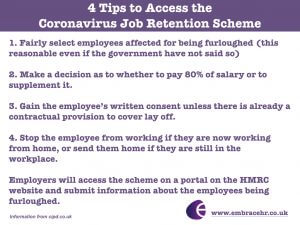As the government encourages construction and manufacturing businesses to get staff back to work unless they can work at home, we take a look at what SMEs need to consider to ensure their staff are kept safe…
The current message from the government is now for businesses to start getting back to work if they possibly can. And with a clearer idea of how long the Coronavirus Job Retention Scheme (furlough) is to go on for, and a plan for getting people gradually back to work in place, now’s the time to look at how to manage staff back.
For now, anyone who can work from home should do so, but the government is suggesting that other employees get back to work by June where appropriate. The CIPD has said that employers should meet the requirement of a three-point checklist before bringing staff back to work. These are as follows:
- Firstly, that it is essential for employees to be present in the workplace
- Secondly, that it is safe for them to be there
- And thirdly, that both employers and workers agree that they should come back into the workplace.
The workspace
The key questions to pose before your office staff return to work are:
- Can they still work from home?
- When they do come back to work how will that be achieved to maintain social distancing and minimise the risk and spread of infection?
You must consider how staff can safely distance from each other, not just when sat at a desk, but when walking around the office, using the toilet and drinks areas. You need to work out safe walking routes around the workspace and, if space is tight, consider splitting shifts or alternating days so that you don’t have all of the staff in at all times. Screens should only be used if you have no more space to distance employees, and meetings should be avoided. If they must take place, keep everyone distanced or take it outside if possible. Hot desking is also to be avoided. If someone has to use another desk, computers and phone, or other equipment, these should be thoroughly cleaned between users.
Changing the way you work
Perhaps this whole situation has made you realise that your staff can work from home. Maybe you don’t need an office or can utilise a smaller space. Now is a good time to consider how your business might look in the future. Start looking at the implications of people working full time from home – what do you need to do to make this happen – for instance:
- Do you need a more robust IT provision in place?
- What extra insurance cover will you need?
- Have you been using Microsoft Teams or other collaborative software? Can this work in the future? If not, consider what sort of software and systems you need to make the shift in order to work more effectively and efficiently.
Getting to work
The message is that the youngest school children and those in Year 6 (age 10-11) will go back to school first. For some of your staff this will mean that they have children who cannot be left at home alone. Remember that even if your staff have slightly older children, they may have needs that mean they cannot be left at home all day either. Also, staff who need to use public transport may be unwilling to do so. In both cases, you need to have an open discussion with them about what the alternatives are:
- Can they continue to work from home?
- Can they work different hours to avoid going on busy transport systems, or work around a partner’s work hours to enable childcare?
Keeping safe
Government guidance says that all employers should be carrying out risk assessments on returning to work, consulting both with their workers and trade unions where applicable. If you employ more than 50 people you will be expected to publish the risk assessment on your company website.
To keep any contact to a minimum, staggered shifts and keeping staff in the same teams are good ways to minimise the number of people with whom they come into contact.
On construction sites, staggered arrival times and multiple entrances are suggested, along with screens to separate workers. Where social distancing is not possible, workers should work back to back or side by side. Swapping of tools should be avoided to lessen the risk of contamination.
In addition, in factories, plants and warehouses, employers should look at how people can work away from each other, in order to maintain the required social distancing, and to stagger the times and locations of breaks.
Working in other people’s homes
If your staff work in people’s homes, such as carers and support workers, or even nurses, they should discuss how social distancing will be achieved. However, working with people means often being close to them. They may require personal care which means that social distancing is not possible. There are other areas to consider. Recommendations can be to leave all internal doors open to minimise touching door handles; restricting the number of people working in normal busy areas such as kitchens and bathrooms; and the mantra of ‘wash hands on arrival and regularly throughout’ cannot be repeated enough. And, of course, it should go without saying that everyone – whether in the home or workplace – should try and minimise the spread of infection.
Restaurants
Keep kitchen access limited to essential staff to minimise any contact. If the kitchen is large enough, install screens to separate workers and only allow one person to enter walk-in freezers and pantries at one time.
Shops
Shops should limit customers in the premises to maintain social distance, use contactless payment where possible and reduce customer service to enable the safety for staff.
Vehicles
If your staff use the company’s vehicles, they should be provided with hand sanitiser and cleaning products. Keep staff in teams so that contact is minimised and supply screens to keep them separate if possible. Contact for deliveries should be kept to a minimum, using online payment and pre-arranging for goods to be dropped off in a safe and secure area.
You can read the full government guidance on working safely here.
If you would like to discuss this subject further and find out how we could help you with work from home contracts, risk assessments, staff safety, the furlough scheme and other COVID-19 related issues, please contact Cecily Lalloo at Embrace HR Limited.
T: 07767 308717 or contact us here.
If you would like to receive our quarterly newsletter, please sign up here.
Based in Aylesbury, Buckinghamshire, Embrace HR Limited supports business owners who do not have their own HR department or those that do but need help from time to time. We also work across the Home Counties of Oxfordshire, Bedfordshire and Hertfordshire, and also SMEs based in London.









